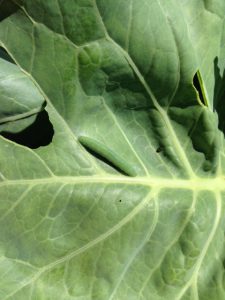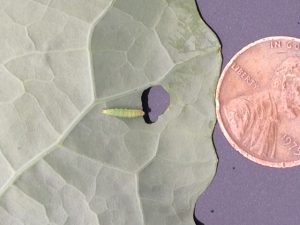Sweet Corn
The Vegetable IPM blacklight trap network is nearly complete. With limited numbers of traps having been checked, only one European corn borer (Allentown, Mercer County) and one corn earworm (Old Bridge, Middlesex County) have been recorded. As sweet corn is currently in the seedling stage, neither of these catches represent a threat. As catches become more consistent, maps of the adult populations of these two pests will be published in the weekly IPM Update.
Cole Crops
With warm, sunny days, IPM personnel have discovered a number of heavy infestations of crucifer flea beetle. These beetles can build to high populations quickly, especially where wild mustard and related cruciferous weeds are common. Extreme feeding on small transplants can cause irreversible damage if not controlled promptly.
While flea beetles may be controlled with foliar applied insecticides, it is possible to get 2-3 weeks of protection by using a soil applied systemic insecticide at planting. This insures good establishment of the transplants without significant flea beetle injury.
Soil applied materials include (active ingredient – trade name (IRAC* code)):
Clothianidin – Belay (4A)
Cyantranilaprole – Verimark (28)
Dinotefuran – Scorpion/Venom (4A)
Imidacloprid – Admire Pro (4A)
OMRI listed foliar materials that will provide some temporary control of flea beetles include:
pyrethrin – Pyganic (3A)
pyrethrin + azadirachtin – (Azera) – (3A + UN)
spinosad – Entrust (5)
 Egg laying by imported cabbage butterflies (ICW) is occurring at this time, and will continue as warm weather permits activity. Infestations of this pest (see photo at left) have been seen by scouts in the central counties, and are likely present in southern parts of the state. Scout plantings weekly. Check 5 consecutive plants each in 10 random locations throughout the planting, paying particular attention to the innermost leaves where ICW often feed. Consider treating if caterpillars are found on 10% or more plants that are in the 0-9 true leaf stage. From 9-leaf to the early head stage (in broccoli, cauliflower and cabbage) infestations up to 20% may be tolerated. Once heads begin to form, a 5% threshold should be observed to protect the marketable portion of the plant. For leafy greens such as collards and kale, 10% plants infested is the threshold throughout.
Egg laying by imported cabbage butterflies (ICW) is occurring at this time, and will continue as warm weather permits activity. Infestations of this pest (see photo at left) have been seen by scouts in the central counties, and are likely present in southern parts of the state. Scout plantings weekly. Check 5 consecutive plants each in 10 random locations throughout the planting, paying particular attention to the innermost leaves where ICW often feed. Consider treating if caterpillars are found on 10% or more plants that are in the 0-9 true leaf stage. From 9-leaf to the early head stage (in broccoli, cauliflower and cabbage) infestations up to 20% may be tolerated. Once heads begin to form, a 5% threshold should be observed to protect the marketable portion of the plant. For leafy greens such as collards and kale, 10% plants infested is the threshold throughout.
Although none have been discovered yet, it is not too soon to begin preparing for infestations of diamondback moth (DBM) larvae (see photo at right). Some populations of DBM are resistant to carbamate and synthetic pyrethroid insecticides. The lack of DBM control with these insecticides has been noted in NJ previously. It is important to distinguish between common cole crop pests for this reason. DBM larvae grow to a length of approximately 0.5”, and taper toward both ends. These caterpillars thrash violently when disturbed. ICW grow to a length of approximately 1.25” and are covered with short hairs. Newer chemistries that specifically target caterpillar pests are effective against DBM as well as all other caterpillar pests of cole crops. These materials include (active ingredient – trade name (IRAC* code)):
Spinosad/Spinetoram – Entrust (OMRI listed)/ Radiant (5)
Chlorantraniliprole – Coragen (28)
Cyantraniliprole – Exirel (28)
Insecticides based on the soil inhabiting bacterium Bacilllus thuriengensis (B.t.) may also be effective on caterpillar pests of cole crops. Examples include Xentari and Javelin. These materials are also OMRI approved. If B.t. materials are used, they must target smaller larvae. Do not wait until large larvae are dominant the field, as results may be unsatisfactory. An added benefit of all the aforementioned chemicals is that they have minimal impact on non-target species, including many insect predators and parasites. Spinosad materials should be used in a way that avoids contact with bees.
*Insecticide Resistance Action Committee
Allium Leafminer ( ALM) Update
Infestations of ALM appear to be widespread throughout much of New Jersey, although the most abundant feeding signs have come from early chive plantings. Some feeding has occurred in leeks, garlic and onions, but to a lesser degree. ALM adult catches on sticky cards placed in chive plantings in the central and northern counties appear to have peaked from April 17-26. Catches since then have declined dramatically, although the sample is limited to several farms from Mercer through Morris counties. One more week of sampling should give us a better indication as to when this first adult flight is over. At present, refer to the document found at the following link for further information on control of this pest: RCE Vegetable Crops Online Resource Center Critical Updates to the Mid-Atlantic Commercial Vegetable Recommendations


